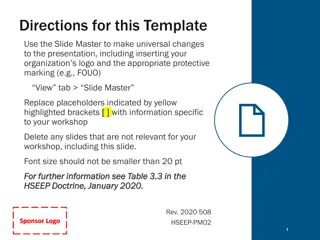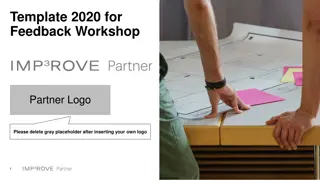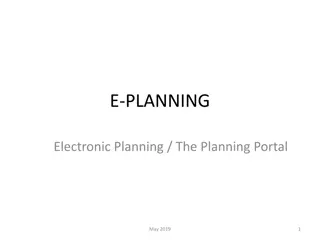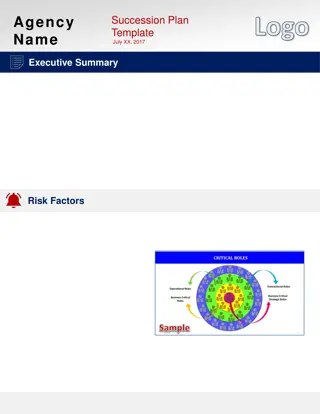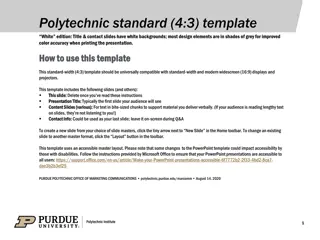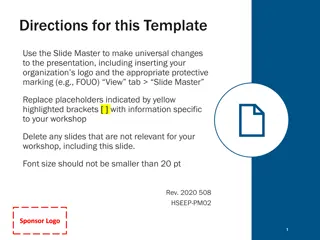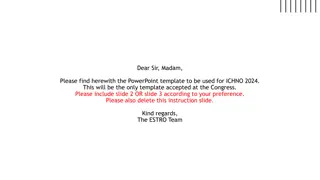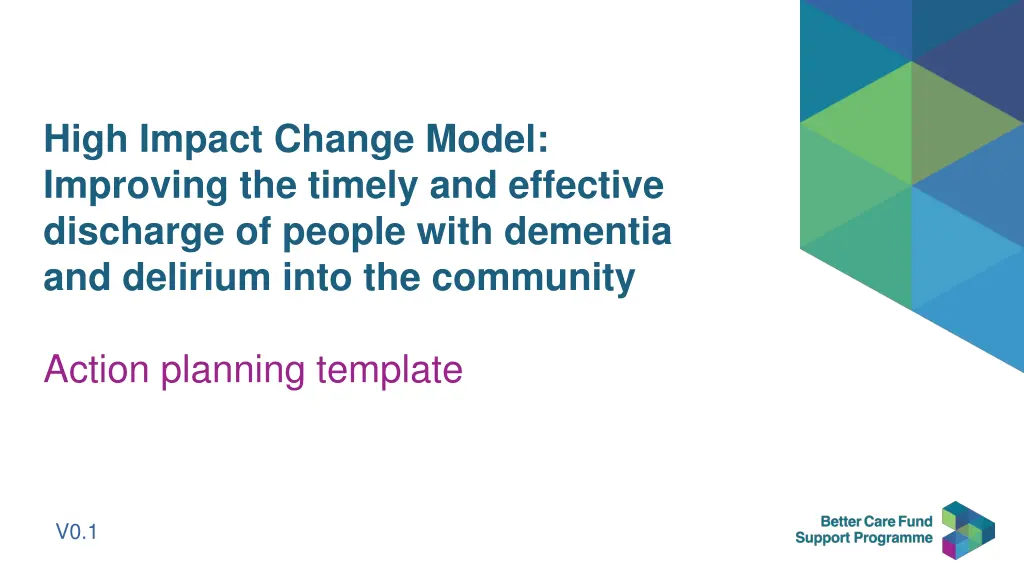
Discharge and Care Planning for Dementia and Delirium Patients
Explore an action planning template for improving the discharge process of individuals with dementia and delirium. Learn about key stakeholders, strategies, and areas for enhancement in dementia care.
Download Presentation

Please find below an Image/Link to download the presentation.
The content on the website is provided AS IS for your information and personal use only. It may not be sold, licensed, or shared on other websites without obtaining consent from the author. If you encounter any issues during the download, it is possible that the publisher has removed the file from their server.
You are allowed to download the files provided on this website for personal or commercial use, subject to the condition that they are used lawfully. All files are the property of their respective owners.
The content on the website is provided AS IS for your information and personal use only. It may not be sold, licensed, or shared on other websites without obtaining consent from the author.
E N D
Presentation Transcript
High Impact Change Model: Improving the timely and effective discharge of people with dementia and delirium into the community Action planning template V0.1
What is the action planning template? Whilst there are positive examples of progress and improvements in care, most areas still face significant challenges, including suitable pathways, standards and having consistent sets of performance measures that enable learning and iteration. Integrated Care Systems (ICSs) that have made progress report that the solutions lie in thinking outside the box and letting our humanity and common-sense shape what we change. This is underpinned by person centred care, realistic medicinal approaches and shared decision making. The changes included in this high impact model have been prioritised on this basis, and this template provides a summarised view of the key outcomes and actions described within the High Impact Change Model (HICM). To get started ICSs will need to identify key stakeholders that will be intrinsic for delivery of the ambitions of the HICM (examples of these have been provided on slide 3). These are not limited to but include representatives from: hospital discharge (including care transfer hubs), intermediate care, urgent and emergency care, adult social care, voluntary care sector, housing providers, clinical and professional leads (older peoples care, dementia, delirium), hospital chief executives, and people with lived experience. It will be helpful to ensure that there is robust joint capacity and demand planning for intermediate services, underpinned by use of BCF funding and joint commissioning using pooled budgets if necessary, as the HICM will enable reflection on how these can be optimised.
Who should be involved? Examples of key stakeholders have been included for ease, but should be carefully reflected to maximise participation as an opportunity to embed a new culture in the ICS for dementia care High Impact Change Area Example stakeholders to be included in review of this area ICS, education and training teams, community NHS and social care teams, Primary Care Networks, VCFSE partners ICS, providers of community NHS and social care, local ambulance service, community urgent response teams, community mental health teams, primary care, crisis resolution and home treatment teams, dementia crisis teams (where available) A Embedding effective support for unpaid carers B Being equipped to prevent and respond to crisis Managing presentations in the Emergency Department ICS, providers of community NHS and social care, Urgent and emergency care leaders, acute hospital leaders, mental health liaison teams - crisis liaison and/ or liaison psychiatry, frailty and geriatric teams C Clinicians/ professionals with specialism in dementia, frailty same day emergency care leads, liaison psychiatry, geriatric care, frailty teams D Timely identification and assessment in hospital E Improving the in-patient experience Acute hospital leaders, ward managers, all staff providing care, dementia champions ICS, Care Transfer Hub, MDTs involved in the discharge processes, VCFSE partners (e.g. admiral nurses) ICS, Intermediate care team leaders, intermediate care commissioners, community NHS and social care providers and multidisciplinary teams in Care Transfer Hub ( including rehabilitation services e.g. occupational therapists and physiotherapists) F Optimising the discharge process Providing intermediate care that promotes positive outcomes G H Facilitating ongoing, longer-term care needs Care Transfer Hub; community NHS and social care, VCFSE partners
What are the benefits of delivering the changes described in the HICM? Decision-making in hospital that fully considers the person s wishes and expert knowledge and experience of the care partner. Reduced levels of distress, deconditioning and loss of independence for the person. Assessment in the person s usual place of residence that is informed by a more accurate baseline, leading to better decisions about what people need. Where needed, the person receives timely and appropriate dementia/delirium skilled care and support in the community, helping to reduce the risk of further deterioration, attendance at hospital or (re)admission. Savings to the system resulting from a shorter length of stay in hospital, a reduction in the required level of post-discharge care and avoidance of (re) admission through effective support in the community. Opportunity to repurpose existing funding to promote better outcomes for the person and their families, e.g. 24-hour care at home short term versus cost of bedded care in a care home (which often results in residential care continuing in the long- term). This is a brief snapshot of what good looks like. The high impact change model describes in more detail the practical activities and steps involved along this and other key parts of the person s journey.
A: Embedding effective support for unpaid carers High Impact Changes Self-reflection status Example metric or indicator of success A Embedding effective support for unpaid carers Poor Adequate Good Carers experience being treated as full partners in decision making A1 Indicator of success: Staff survey (part of a routine organisational staff survey as appropriate), with questions such as: Ensure staff working across acute hospitals, crisis response services and intermediate care services have the training to be carer aware and are equipped with care partner engagement strategies that act on the concern of the care partner. A1.1 - How often are you engaging with care partners in line with the organisation s/system s engagement strategies? - Do you feel able to bring care partners into decision-making effectively? Indicator of success: survey of people with lived experience asking: - Do you feel you are equal and valued partners in Identify and communicate the mechanism to facilitate care partners being heard in discussions and decisions, in line with existing pathways and processes. a. Planning, b. Development, c. Decision making A1.2 (in line with targets set locally for participation) Metric: Number of people with lived experiences or organisations that represent people with lived experience, invited to senior-leadership decision-making meetings Prevention of care partner breakdown through access to timely information and support Develop and provide a repository of information and tools, that can provide universal and equitable access, regardless of location. Health and care professionals (including social prescribers) should be aware of and be able to signpost to this repository. A2 Indicator of success: Staff survey including question: - Do you feel you have complete knowledge of all the relevant local tools and information that would support carers of people with dementia? A2.1 Indicator of success: Survey of people with lived experience asking: Provide accessible respite opportunities to care partners of people with dementia, recognising that these could reduce avoidable hospital admissions. Do the tools/information available meets your needs? A2.2 Do you know how to access respite care, should you need it?
B: Being equipped to prevent and respond to crisis High Impact Changes Self-reflection status Example metric or indicator of success B Being equipped to prevent and respond to crisis Poor Adequate Good Reduced likelihood of admissions and readmissions through proactive crisis support planning. Embed processes that proactively encourage people with dementia to develop a plan, and for teams that support the person to review them. The plan should be owned by the person, within input from their care partners, and be made visible to the teams that support them. B1 B1.1 Indicator of success: ability to track the usage of care plans in the delivery of care for dementia/delirium (or risk thereof), that is coded. ICSs will then have a baseline metric to start from, and a target to reach 100%. B1.2Develop and provide a repository of information and tools (e.g. action cards), that can support crisis planning, including the early identification of signs of escalation B2 Access to comprehensive escalation support when in crisis. Identify the community teams that are able to respond effectively to the presenting needs of someone with dementia (and those with superimposed delirium). This should include the UCR team, and any additional community services that are able to respond. Ensure these teams are known and communicated. Identify and communicate how the community teams responding are able to rapidly access specialist advice (e.g. highly trained clinical specialist, Consultant Geriatrician or Consultant Psychiatrist). B2.1 Indicator of success: Staff survey including question: - Do you feel that you have a good understanding of the crisis response services available in your local area? (% yes/ no + comments) B2.2 - Are you able to access information easily? B2.3Identify and communicate how the community teams responding can have rapid access to diagnostics (and what these diagnostic tools should be). - Is this information useful/helpful and are there any gaps? Identify the teams to contact in hours, out of hours and on the weekend for support for physical and mental health, where otherwise an admission is most likely. B2.4
C. Managing presentations in the Emergency Department High Impact Changes Self-reflection status Example metric or indicator of success C Managing presentations in the Emergency Department Poor Adequate Good Optimal management of people with dementia and delirium in an Emergency Department, aligned to the acute frailty pathway. C1 Indicator of success: ability of senior leaders or service managers to identify the front door frailty response at each acute hospital site. C1.1Agree and implement a front door frailty response/ team in the acute hospital, including how patients with dementia are managed as part of this response. Metrics: WTE/ skill mix; number of people supported with dementia; patient/care partner satisfaction of experience (admission/admission avoidance)
D: Enabling timely identification and assessment in hospital High Impact Changes Self-reflection status Example metric or indicator of success D Enabling timely identification and assessment in hospital Poor Adequate Good Identification and assessment of dementia, suspected dementia and delirium (including DSD), aligned to the acute frailty pathway. D1 Identify and agree who in the Emergency Department (or front door frailty response) will have the skills to best determine the presenting need and complete a clinical frailty assessment within 30 minutes of arrival. D1.1 Metric: % of patients aged 65 and over attending the Emergency Department or same-day emergency care (SDEC) receiving a clinical frailty assessment within 30 minutes of arrival (target 30, and use initial baseline position to work to 30 for all patients) Ensure your assessment process is in line with national best practice and takes a holistic approach to person-centred care. D1.2 Embed a Home First ethos, when making decisions on whether the person is to be discharged from the hospital or admitted to a ward (and where admission is required, optimising the available dementia attuned resources in the hospital). D1.3
E: Improving the inpatient experience High Impact Changes Self-reflection status Example metric or indicator of success E Improving the inpatient experience Poor Adequate Good E1 Provide dementia attuned hospital care Identify a process/ protocol to minimise the number of ward moves from presentation at the hospital onwards. E1.1 Indicator of success: audit and track the number of ward moves for people with dementia and delirium. Identify and target any variation in the agreed process (and respective target) to minimise ward moves on an iterative basis. E1.2 Deliver care in a ward where staff will have the skills to respond to the person s needs. Deliver meaningful activity for people with dementia, that promotes independence and reduces the likelihood of deconditioning. E1.3 E2 Provide dementia attuned hospital environments E2.1 Make simple, practical adaptations where people with dementia are likely to be cared for.
F: Optimising the discharge process High Impact Changes Self-reflection status Example metric or indicator of success F Optimising the discharge process Poor Adequate Good Discharge planning is a standard that starts from admission, engages the person and their care partner, and focusses on getting the person home with the right support. F1 Indicator of success: Reflective case review exercise for acute hospitals to iterate processes and learn from: Develop processes/ protocols that fosters close working between ward staff and care transfer hub (CTH) multidisciplinary teams (or equivalent) to enable earlier discharge planning. F1.1 - Did the person receive the correct dementia/delirium input from the MDT? - Are notes being shared well enough across settings? Teams that support discharge have the knowledge to respond to the needs of the person, maximising opportunities for rehabilitation and independence. F2 Metric: what % of patients with dementia are discharged back to their: usual place of residence (PW0) home-based care (PW1) bed-based care (PW2) long-term care (PW3) Emphasise a Home First approach (in other words, use Pathway 1) for people with dementia that maximises opportunities for independence and actively manages risk across organisations to reach a reasonable balance between safety (at all times) and independence. F2.1 Compared against national guidance, recognising that the threshold for people with dementia and delirium would be different than expected generally (i.e. expecting a more complex distribution than 3% of people being discharged via PW3)
G: Providing intermediate care that promotes positive outcomes High Impact Changes Self-reflection status Example metric or indicator of success G Providing intermediate care that promotes positive outcomes Poor Adequate Good Intermediate care environments that are suitable and attuned to needs of people with dementia, and reduce the risk of (re) admissions G1 Deliver home-based intermediate care (i.e. Pathway 1) that provides a seamless transition from the acute hospital to home (and reduces the need for admission), with the appropriate wrap around support. Metric: how many people with dementia and delirium are discharged to interim placement beds, where there is no therapy input vs rehabilitation or reablement beds in PW2? G1.1 G1.2Deliver bed-based intermediate care (i.e. Pathway 2) that provides an environment and team that is able to offer the right support to deliver better outcomes. Metric: % of people discharged with dementia or delirium were readmitted within 30 days? G1.3If a (re) admission does occur, where clinically appropriate, the person should be returned back to their usual place of residence as a priority. Intermediate care providers to have staff with the skills and knowledge to respond to the needs of people with dementia and delirium G2 Agree a minimum training requirement (basic skills) for any staff involved in the delivery of intermediate care services for people with dementia and delirium, and the ability to draw on more specialised skills where required. Metric: % of staff having basic skills training for dementia and delirium (target 100%) G2.1
H: Optimising the discharge process High Impact Changes Self-reflection status Example metric or indicator of success H Facilitating ongoing, longer-term care needs Poor Adequate Good H1 Assess people for long-term care at an optimised time Clearly describe the process for individuals on a discharge pathway from hospital to access an appropriate assessment for their long term care needs, either through a Care Act assessment. or for a small number of those with the highest levels of complex, intense or unpredictable needs an assessment for NHS Continuing Healthcare (CHC). H1.1 Indicator of success: Staff survey including question: - Do you feel you have complete knowledge of all the relevant local tools and information that would support end-of-life care for people with dementia? H2 Enable personalised support in end of life care Clearly describe the service offering, ensuring there is equitable access for people with dementia and delirium to high quality, compassionate, integrated palliative and end of life care. H2.1





